
Original Link: https://www.anandtech.com/show/2924
The Clarkdale Experiment
I’ve been waiting for Intel’s 32nm CPUs to arrive on the scene, because I’ve been wanting to build a small, but relatively potent, gaming system. Now, Anand wasn’t all that impressed with the price/performance ratio of the Intel Core i5 661, suggesting that Intel had priced the CPU too high relative to the competition.
Interestingly, Anand also found the power consumption to be a little iffy, noting that his system idled at around 110W (though he did suggest it was high partly due to the particular Asus motherboard he used in the CPU review.)
I saw an opportunity with Clarkdale to do a little experimenting. I wanted to build a small gaming system with low idle power, but capable of running high end games at high frame rates. The $205 Core i5 661 looked to be just the CPU for that – two cores, two more virtual cores seemed like a good fit for even modern game titles. All you need is a better GPU… and maybe a few other things.
For example, I’d need a good discrete graphics card. Storage was relatively important, but I could get by without dropping in a terabyte drive. This system wasn’t intended to be a repository for digital video. Even though modern PC games take up a lot of space, there even a 250 or 320GB drive is ample enough to hold quite a number of games. For example, I probably have a dozen current generation games installed using Steam, and my Steam folder is just 131GB.
So in my mind, Clarkdale can enable a different class of system. Right now, I’ve got a system running a different Asus motherboard (the P7H55D-M EVO). It’s also got a discrete graphics card in it. After I build a system, I always run 3DMark Vantage as a kind of sanity check to see if it's all working properly. This little monster generates a 3DMark Vantage score of 12,738.
Did I mention that it idles at just under 70W?
Let’s see exactly how I built this thing.
The Components
Bear in mind that this system is an experimental build. So you’ll get to go along for the full ride, including all the gotchas and warts I encountered. Sometimes you learn more from the mistakes and glitches than if everything went smoothly.
First, cost was no object. That didn’t mean I had a bottomless budget, but it did mean I wasn’t going to skimp on components. The goals for the system were pretty simple:
- Low power usage at idle
- Good gaming performance
- Very quiet
- Relatively small. It would be something you could lug around to LAN parties.
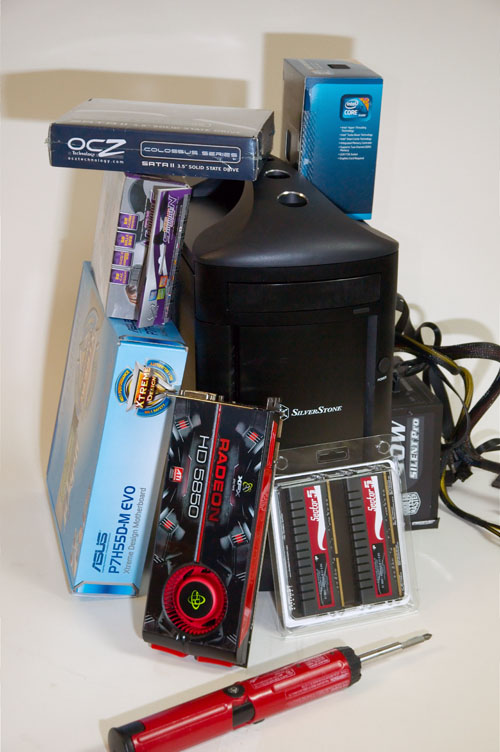
Let’s check out the component list.
|
Component |
Brand / Model |
Cost |
|
CPU |
Intel Core i5 661 |
$205 |
|
Motherboard |
Asus P7H55D-M EVO |
$135 |
|
CPU Cooler |
Scyther Big Shuriken Low |
$ 35 |
|
Memory |
4GB Patriot Viper II Sector 5 DDR3-1600 |
$110 |
|
Graphics Card |
XFX Radeon HD 5850 |
$299 |
|
Hard Drive |
OCZ Colossus 250GB 3.5” SSD |
$849 |
|
Optical Drive |
Asus BC-08B1ST Blu-ray combo drive |
$110 |
|
PSU |
Cooler Master Silent Plus Pro 500W |
$100 |
|
Case |
Silverstone SG04B-FH |
$159 |
|
OS |
Windows 7 Home Premium OEM x64 |
$105 |
|
Total |
|
$2,107 |
That’s over $2,100 for a dual core gaming rig. Of course, for the $850 cost of the SSD, you could practically build a new system. But we’re in the pursuit of knowledge here, so damn the cost and full speed ahead.
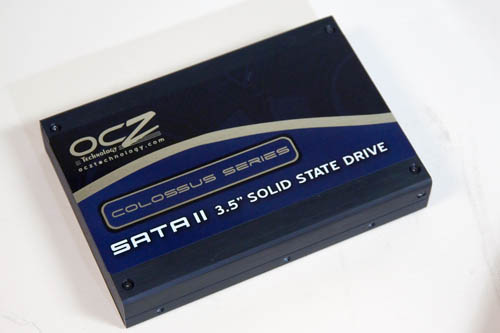
The Pain of Assembly
Building a small form factor system is an exercise in flowcharts. If you’re using a highly compact case, like the Silverstone SG04B, the order of assembly is critical. The power supply, for example, goes in last.
The Asus motherboard offers a fairly clean layout, so there’s ample room for a large CPU cooler. However, I discovered late in the game that the SATA ports are poorly located, which means a long graphics card butts up to some of the SATA connectors. The board has plenty of ports, however, and does support USB 3.0, with an onboard NEC USB 3.0 controller.
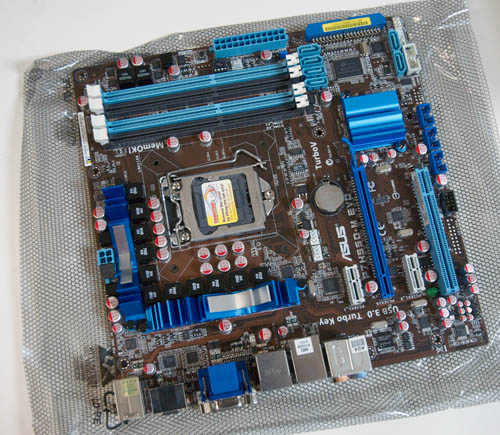
Attaching the CPU cooler was challenging, too. I’ve generally liked Scythe coolers, but the designers often don’t think about how you actually mount the HSF. The Shiruken is a very low profile cooler, just 58mm high, including the skinny, 120mm fan. However, it’s fairly large, at 4.7 inches square. Plus, the Intel mounting tabs are under the radiator.
All this meant two things: I needed to install the HSF before installing the motherboard in the case.
Installing the cooler was an exercise in patience. I needed a large, flat bladed screwdriver, because there was no way I was going to get my fingers in between the HSF radiator and the top of the mounting pushpin, and still exert enough force to press the connector down until it snapped into place. Even then, I wasn’t 100% sure that all four pushpins had locked down.
And the Patriot memory modules, with their slightly taller silhouette, meant that two of the memory sockets weren’t usable. Lower profile memory modules would have allowed me to install four modules instead of two, if I wanted to go beyond 4GB.
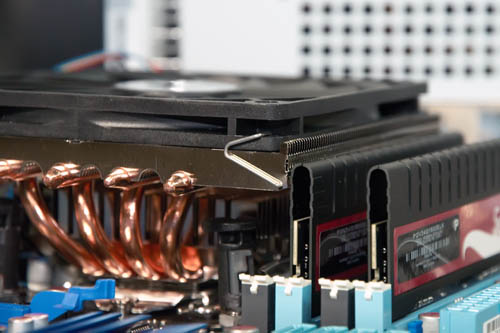
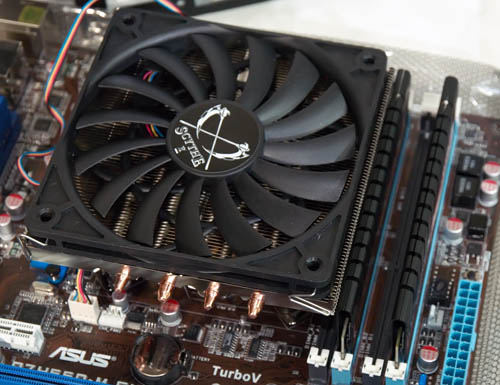
Once the heat sink, CPU and memory were in place, the motherboard slid into the case nicely. It’s definitely a snug fit, since the case is just the right size for a micro ATX motherboard.
The biggest pain, though, was installing the Radeon HD 5850 graphics card. The XFX card is based on the reference design, and is 9.5 inches long. However, the power connectors are on the rear of the card. This had two consequences: you needed to attach the PCIe power plugs before installing the card in the case. Secondly, getting the card into the case meant slipping the card in at an angle, holding cables out of the way, and making sure you didn’t bump SATA or front panel connectors.
Due to the location of the SATA ports, I had to route the SATA cables over the top of the graphics card. Otherwise, I’d need to run them under the card, and that space is already pretty crowded.
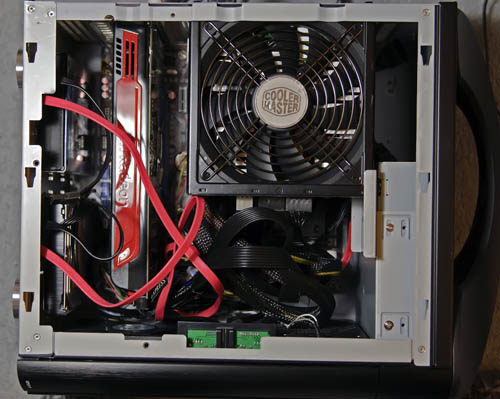
The Silverstone case mounts hard drives in the base of the case, which is removable. However, as with the motherboard tray, space is tight, so you need to attach SATA and drive power after you close up the case bottom. I needed to be very careful, as the power adapter and SATA plug have barely enough room. It would be very easy to damage a SATA drive connector.
Once I figured out cable routing and got the graphics card running – which took several cycles of installing and removing the card, then re-routing cables – I booted the system. Everything was good. Installing Windows went smoothly.
The OCZ drive is fast, too. It’s in a 3.5-inch shell, rather than the more common 2.5 inch mechanism, and is really two 128GB modules pre-configured inside the shell for RAID 0. (Users never see the RAID configuration.)
Postmortem: Success at What Cost?
I was a little worried about CPU idle temps, since installing the CPU cooler had been a somewhat uncertain process. As it turns out, idle temps were around 34C, so no worries.
So far, the system has met all the goals I set out for it. As noted earlier, it idles at under 70W, yet can generate a pretty substantial 3DMark Vantage score. I plan on following up in about a month with additional performance numbers, as well as data on real world gaming experience.
It’s also amazingly quiet. Even with the case side panel open, the system is whisper quiet after the initial boot noise. Even the noise of the Radeon HD 5850 is pretty low, until you fire up a demanding game.
Still, at over $2,100, it’s an expensive little system. What would a budget version of this rig look like? I’d like to suggest some possibilities for saving money:
- Use a 500GB, 7,200RPM SATA drive. $800 less.
- Build the system into a Antec Sonata III, which ships with a 500W PSU. That saves $148
- Use a DVD+/-RW drive instead of the Blu-ray combo drive; that’s another $70.
- Instead of a Radeon HD 5850, go with a 5770. You’ll still get pretty good performance, and knock another $130 off
The system wouldn’t be quite as fast nor as quiet, and certainly less portable. Its power utilization would be nearly the same – maybe lower at full throttle, since the 5770 is less power hungry than the 5850. That system would cost less than half – about $960. As usual, pushing for better performance means the cost can rise quite rapidly.
So far, I very much like this little system, but I’ll see how it fares in the next few weeks. Will I still think it’s the bee’s knees after hammering it with some real games? I’ll let you know.







